#it IS funny to think about how love has lived through 2 economic recessions and multiple wars yet that’s not even top 5
Text
pushing back love’s timeline just by a few years (10 years) bc it’d make a little more sense to me + i think it’s funny if they’re old and yet still act like that
#﹙♡﹚! 𝗚𝗘𝗡 ﹕ooc﹒ ꔛ ۫ ⸝⸝#so they’re 118 as of 2024 instead of 108#i DID consider them being born in the late 1890s just bc i think it’d be funny if they technically lived through 3 different centeries#but timeline wise it doesn’t line up with my plan :p#it IS funny to think about how love has lived through 2 economic recessions and multiple wars yet that’s not even top 5#most traumatic things that happened to them
8 notes
·
View notes
Text
How to fuck Bolsonaro and save the planet
“Unless you have already found a nice comfy cave up high in a mountain and stacked it up with canned food enough to last for decades, Jair Bolsonaro’s promised attacks on environment has to be stopped immediately!”

So it happened. Despite our crossed-fingers and before-bedtime prayers, world’s 5th largest country and 8th biggest economy is handed over to another misogynistic, homophobic, gun-loving arsehole. Jair Bolsonaro, rightfully nicked the Tropical Trump, won majority of the votes in the second round of the presidential elections in Brazil. It’s another dark day for us all.
Dear reader,
At this point, you might be saying “why the fuck should I care about Brazil’s new president”. You may not care about the women’s or LGBT rights in Brazil or let the relaxation of gun laws be Brazilians’ own problem (for all of which I might say, you`re completely wrong), but please know that on one important issue, Bolsonaro has promised to fuck not only Brazil, but the whole planet including your own pink arse: the environment.
With 450 million m3, Brazil is already the world`s 11th biggest CO2 emitter. On the plus side, Brazil is home to 3.3 km2 of Amazon rainforest, by far the biggest in the world. What Bolsonaro has been promising in his campaign was to go wild on the CO2 emissions, while wildly destroying the already threatened Amazons. Here’s a list of his campaign promises on environmental issues:
Withdrawal from the Paris agreement which has set targets for limitation of CO2 emissions to combat climate change
Shutting down the Ministry of Environment
Building a new motorway right through the Amazons
Opening up new areas on indigenous territories to mining
Relaxation of environmental law enforcement and licensing
Beefing up the alliance with the beef lobby which is already responsible for cutting down thousands of km2 of rainforest to open farmland.
Banning international environmental NGO’s like Greenpeace and WWF to operate in Brazil
In a time when scientists are already ringing the alarm bells at the highest level, actualization of even half of these campaign promises will be disastrous for all of us living on this planet. We can discuss for days the bad policies that has led Bolsonaro to power or write volumes on the rise of alt-right across the globe, but unless you have already found a nice comfy cave up high in a mountain and stacked it up with canned food enough to last for decades, Bolsonaro’s promised attacks on environment has to be stopped immediately, before they even start. Let’s discuss a few ways how.

We already know that, despite all the Jesus-praising, family-values-loving bullshit they talk non-stop about, guys like Bolsonaro care for and understand from one thing much more than anything else: Money.
Brazilian economy is already very fragile, trying to recover from years of recession, making it the Achilles’ (or in this case, Bolsonaro’s) heel If we can make this arsehole hear loud and clear that for any detrimental action he takes on the environment, we will strike back with our combined economic force, we can push him back to the hole he sneaked his miserable head out of. Below, I tried to list a few things you can easily do without losing your comfort too much.
Don’t Go
Brazil receives more than 6.6 million international tourists each year, leaving a revenue of more than 7 billion dollars. So, unless you’re planning to go and stand in front of the bulldozers chopping down the rainforests, postpone that tropical visit to another time. Or if you really want to see the rainforests and white sandy beaches that bad, try Costa Rica perhaps, where they are very close to becoming the first carbon neutral country in the world (and don’t forget to find ways to off-set your carbon footprint from that long intercontinental flight :)).
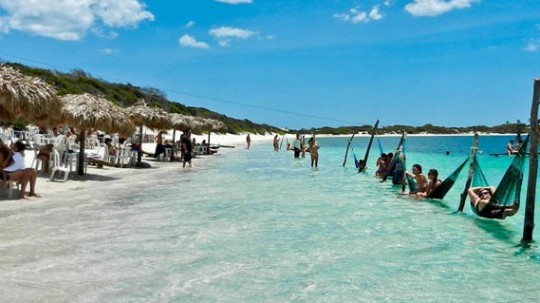
Eat Less Meat
I’m not saying go full-on vegan -not that it hurts- but eating less meat may be the most efficient way to hit back at Bolsonaro. Brazil’s biggest exports by far are animal agriculture related items (beef and poultry meat, soybeans and corn used as animal feed, etc.). By reducing the demand for Brazilian beef, chicken and soybeans, you will not only throw a punch at the Brazilian economy, but also take away the reasons for opening up more farmland in the Amazons.
Now, you might argue that you only eat local meat, not any of that Brazilian stuff, so this does not apply to you. Here’s a few counter arguments then: For starters, in many cases, cattle are transported live (in horrendous conditions, often from Brazil) and slaughtered locally, making its `country of origin` the land where the slaughterhouse is and not where the animals were raised. So, you often don’t really know whether that entrecôte you bought from the supermarket actually comes from Farmer Joe’s ranch or the Amazons.
Secondly, it is very likely that your country raises not enough chicken or cattle to meet the local demand, therefore even if you’re eating local meat, you are pushing others to eat imported stuff. By reducing the demand, you will force your local animal farmers be more competitive against Brazilian exporters. We all know that no politician wants to stand up against farmers, so goes up the tariffs against Brazilian beef and chicken.
And even if that is not the case and there is no Brazilian beef or chicken sold where you live, those animals were probably still fed on soybeans grown in Brazil. Soybeans alone account for more than 19 billion dollars (yes, billion with a ‘B’) of Brazilian exports. So, by just eating less meat, not only will you drop those cholesterol levels you’ve been worrying about, but also fuck Bolsonaro with a healthy smile :).

Use Less Fuel
Funny hey, what seems to be already good for the environment is bad for Bolsonaro. 5% of Brazil’s exports income comes from crude oil. Simply by cleaning up your old bike and pedalling to work, you will both reduce your own carbon footprint and also help drop the global demand on oil. Lower demand means lower prices, which in return results in a stick up Bolsonaro’s arse (plus the Saudis’, double good :)).

Consume Less Sugar
Equally funny, what seems to be already good for your health is also bad for Bolsonaro. Raw sugar accounts for 5.7% of Brazil’s exports. Cutting down on those pop drinks as well as pedalling to work will do wonders on that belly of yours. Another fine strike at Bolsonaro (with an added bonus hit at Coca-Cola :)).
For any arguments about consuming locally produced sugar, see the counter arguments for meat. The same principals apply and those love handles have got to go :).

Quit Smoking
Did you know that Brazil is a major tobacco exporter? I won’t even bother to elaborate further :).
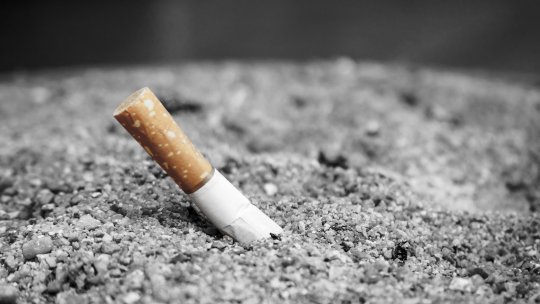
Drink Less umhh... Coffee
Okay, this one hurts me the most. I am not going to preach anything I cannot follow myself, but you can check out the country of origin mark on this one. Unlike meat and sugar, the `Product of Brazil` mark has an added economic value when it comes to coffee. Yes, you get good coffee from Brazil, but not all good coffee comes from Brazil. So, next time you reach for the black stuff, make sure they originate from a better place (and is fair-trade). Costa Rica? Hey, you can even start an online petition to Starbucks on this one.

The same principal applies to pretty much everything. Whatever you’re looking to buy, make sure it is not `Made in Brazil`. That private jet you want to buy so much for example, don’t buy it from Embraer - bikes are way cooler anyway :).

Contact the NGO’s
Call your local Greenpeace and WWF office -since they have been promised to be silenced by Bolsonaro- and ask what their plans are (and if they can’t answer back, ask why the fuck they cannot). Try to get involved in their efforts to combat the evil. This is a global problem that will require global cooperation. Be part of it.

Contact Your Politicians
If you, by any chance, live in a country where the politicians give a rat’s arse to what the voters think, contact them and explain your concerns. Ask them to take measures against the guy who promises to destroy the future of your kids. And if they don’t listen, vote them out in the next elections and bring in those who will.

Inform Others
There is a good chance that your media have not given the deserved attention to what is happening in Brazil and you have heard of it only by pure luck. For every person who is informed about the issue, there are hundreds of thousands who is not. Use every social and antisocial media you can find to tell them about the great danger and urge them to take action. We cannot solve this problem on our own. Group up and combat together.
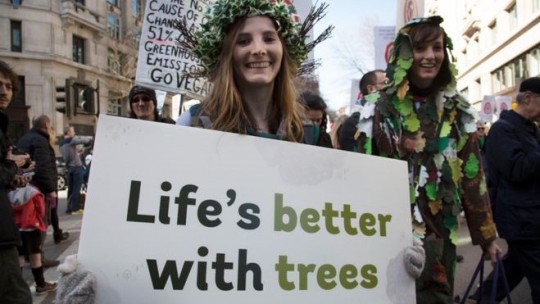
Reach Out
Bolsonaro is Brazilian, but not all Brazilians are Bolsonaro – just like not all Americans are Trump, not all French are Le Pen, not all Dutch are Wilders. Half of the country voted against the bastard. And out of 210 million Brazilians in the world, there’s a chance that you might have befriended one or two. If so, reach out to them. Local knowledge is golden - ask how you can help them further to stop the devil reincarnate. Make them feel your support at these troubling times in their country because you will need their support when the same shit happens in yours.
So, shall we samba?

#international#politics#brazil#bolsonaro#global warming#climate change#environment#action#greenpeace#wwf#amazon
2K notes
·
View notes
Video
youtube
Is 2020 the New 2012?
“Judgment day and the end of the world is in our minds..and our minds are a dangerous place to be” -Kelly Cutrone.
Hey, hey, Remember when everyone said the world would end in 2012 and they made a movie about it and everything? And everyone was saying that there would be cataclysmic events like Massive fires, World War 3, plagues of locusts, floods, and mass civil unrest...leading to complete shutdown of all society?? Yeah, so uh funny story while we all know that didn’t happen in 2012, cause we’re all still here almost every prediction people made about how the world would end back then has pretty much come true for 2020. Wildfires exploded across Australia at the tail end of 2019 and were most influential in January. WW3? In January, after the assassination of Iranian general Qasem Soleimani, tensions between the US and Iran were at an all-time high, with attacks on the US Embassy in Baghdad sparking fears the next war could happen pretty soon. Swarms of locusts eating 1000s of crops and causing famine? February in Kenya. Flooding March in the UK. Civil unrest and anarchy in the streets? Mark another one-off for Apocalypse Bingo! Still wondering if we’ll get our hoaxed alien attack this year.
You really would be forgiven for thinking the Maya just got the math wrong on their calendar. Maybe the stonemason just had too much Peyote that day, who knows, But believe it or not, there is a conspiracy about this going around. Our current year 2020 is 2012, and it all has to do with the time that we adopted the Gregorian Calendar as opposed to older Julian one. Now Before we start, let’s just say, there are a few significant issues with this theory, the least of which is that different parts of the world adopted the Gregorian calendar at different times, so it wasn’t a universal thing that you can just calculate the math on and BANG - you’ve got yourself a day to lock yourself in your doomsday bunker with your mask and your Kool-ade... but we’ll get there soon.
So what is this whole thing about? Last month, a man named Paolo Tagaloguin, who claims to be a researcher/Fulbright scholar took to twitter (in a now-deleted post that he claimed was a joke) and did some somewhat questionable math and came up with a theory that said:
“We were technically in 2012. The number of days lost in a year due to the Gregorian Calendar shift is 11 days. For 268 years using the Gregorian Calendar (1752-2020) times 11 days = 2,948 days. 2,948 days / 365 days (per year) = 8 years”....
Which according to him, put Apocalypse II: Nibiru Boogaloo on the 21st of June 2020. Now it’s July, so that didn’t happen. As we said earlier, there are quite a few issues with his calculations that prove him wrong. To start with, Let’s get some background info. The Gregorian Calendar is essentially the most widely used calendar and dating system used in the world today. It splits a canonical year into 12 months, and spaces leap years to make the average year 365.2 days long, focusing predominantly on Earth’s revolution around the sun as a means of keeping time. If you live in the world today, chances are you at least know this dating system.
It was invented by Pope Gregory XIII and gradually replaced the much older Julian Calendar that was in use at the time, which some people say gave us April Fools day! See, aside from Christian influences - like changing how the lunar cycles were calculated by the church to get a more accurate date for Easter, and the time of the New Year, the Gregorian Calendar also shortened the average year by 0.0075 days to stop the drift of the calendar concerning the equinoxes. The Julian Calendar, though, was proposed by Julius Caesar around 46BC and was invented with the help of Greek Mathematics and astronomy and had been used up until 1582.
This is where we see the first issue with Tagaloguin’s theory. Not only does it not take into account leap years, but the date he used for its adoption (1752), is only the date that the New Calendar was adopted in Britain and its colonies (otherwise known as the area of the United States east of the Appalachian Mountains). Much of Europe (including a lot of Catholic countries), such as France, Spain, Lithuania, and much of the not-so-Holy Roman Empire had adopted it right from the start, though, in 1582. Some of the first records showed a funny glitch in the dates where Thursday 4th October 1582 was followed by Friday, 15 October 1582, the next day - seriously! Go on a calendar app and check it out. It’s amusing.
Arguments between Protestant Christians and Catholics, though, led to a delay in the Calendar taking off in the rest of the world, with some countries not even changing until the 18th Century! Which meant that they had to observe an additional leap year, which is where we get the 11 days to change from. The French and Spanish colonies in the US adopted the change when their home countries did in the 1500s, so, in short, the math is entirely wrong…
The other thing to consider is that the whole 2012 phenomenon was a huge misunderstanding. We’ve covered this on the channel before, but in a nutshell, the world was never going to “end,” at least, not in the sense of the movie cataclysms or anything. See, the calendar would reset at the end of the 13th Bak'tun - rather than end life on Earth entirely. If anything thinks of the Maya calendar like a car’s mileage counter, once it reaches 99,999,99, it just resets to 0...or 1 since we can’t have a year 0. The thing about the Maya is.. they LOVED their cycles. They thought everything was a cycle, which - if you’ve seen our episode called Cycles n Sine Waves, or ever read any of the Hermetic Writings - it makes sense that as things naturally move in waves, cycles appear to be built into the fabric of the cosmos. In Mesoamerican mythology, even the world itself went through 4 creations and re-creations before the gods got it right. Something about raining jaguars or giant floods kept messing everything up. Enlil, what have you got to say for yourself?
Anyway, my point is, did the Mayan calendar end on December 21st, 2012? Yeah technically. But they didn’t see it as an “ending,” once the Bak’tun reached its end, it would merely transition into a new phase, and trigger a kind of Rebirth for all of our cultures, the beginning of a new massive cycle of time. A lot of New Age beliefs saw this rebirth as a dawning of a new age of consciousness, where people would go through a period of great transition, leading to an overall higher knowledge for all of humanity, and we would eventually move into a new heart-centered age, and this was the beginning of that shift. Would this have been a period ending the Maya thought was wicked cool? You bet! The most significant period endings they experienced were Bak'tun endings. So it was a huge deal, just not a world-ending huge deal. Well, maybe it depends on how we describe it. Is it the end of our old way of life as we know it? Yeah, we could probably say that!
Given our current climate in 2020, it’s easy to look for energetic or spiritual excuses for everything that’s happening, and maybe there is something to be said about how we account for time. The energy is coming back around to clear out old ways and paradigms before moving into a new one. It’s interesting to see that almost everything that we thought would happen in 2012 is happening now. Almost like we didn’t learn the first time around, so we’re repeating the energy until we finally break through and change for the better.
You might be wondering why a crazy theory like this took off so quickly, despite its questionable math, well part of it also lies in Astrology. We covered the Astrology of Coronavirus earlier in another video, so definitely go check that out for some relevant Planetary Gossip..but the thing is Astrologers have been hyping up 2020 as a year of radical change for many many years now, thanks to the rare alignment of Saturn and Pluto on the 12th January, which was made more prominent by Jupiter coming in shortly after that, which is the angle we looked at in our COVID Astrology episode. While no one could have predicted how epic a catastrophe Corona would be, we did get at least one apocalyptic cataclysm! Many Astrology charts predicted that this year would mark history by challenging us in some pretty extreme ways.
This is one of those things that I’d love to see some scientists take more seriously. At the same time, Astrology is often ridiculed as a superstition. How is it that so many astrologers have been telling us about the significant change of 2020 for decades in advance, hitting the nail on the head perfectly?
According to Chani Nicholas, right from the beginning, January’s conjunction was a scary start, as it’s episode coincided last time with both World Wars and the economic recession of the 80s, so we were in for it from the starting line along with 2 Mercury retrogrades this year, and the latter being during the next election some more stuff is bound to go down before we’re through the 2020 woods. It’s not all doom and gloom, though, given Neptune's position, which suggests we’re entering a period where we will feel more interconnected and understanding of each other than ever before. And with Venus’ recent retrograde in Gemini, we have an energy of renewal and reassessment with relationships, both with others and ourselves. This is a time of apocalyptic matters - and if you recall from one of our flagship original spirit science episodes - apocalypse translates to a “lifting of the veil.” So 2020 is a time where the truth is coming out, we see all of the chaos of human consciousness with crystal clear vision, as the truth comes to the surface, for it to be healed.
Even better though… 2021 is supposed to be GREAT. With the conjunction of Saturn and Pluto in Aquarius on the winter solstice, we’ll be entering a period of a fresh start, especially about science and innovation. Chani seems to think that the new energy will probably guide many industries to change in ways that will make them practically unrecognizable. Some new and surprising concepts and innovations will be coming out in how we live in harmony with the Earth and her resources. Maybe we’ll even see the electric human blackfly drone machine come to the market and Hey, we might even start laying the groundwork for our Spirit Center next year, we’ve got some huge plans for that, but we’ll have to save that discussion for another time.
So, If the 21st of June 2020 wasn’t the end of the world. Did anything interesting happen on that day at all? There wasn’t anything as dramatic as tidal waves or volcanos going off and destroying everything around it, But it was world Yoga day! And world selfie day, and world optimism day, and indigenous peoples day (yay) and well you get the picture, we made it into a lot of different things. Astronomically it was pretty cool too; there was a solstice new moon solar eclipse in cancer! Only parts of Central and Eastern Africa and some parts of southwest Asia could see the eclipse, But still, someone somewhere probably thought the world was ending.
So long story short Is 2020 the new 2012? If we see 2012 as a time where the energy shifted and brought us into a new age, then Kinda! A lot of what’s going on at the moment in the world is dramatically changing our cultural climate and collective consciousness. The riots especially are uprooting long-held old systems of oppression and making way for new, more progressive energies and mindsets, which is fantastic. Is the world going to end at some point this year? No more than it did 2012.
When a cycle ends, the calendar is meant to be reset to the beginning and start. It's intended to be a time of change and renewal, which 2020 certainly is. Spiritually speaking, perhaps the new energies introduced to us in 2012 have finally integrated into our society and are shaking things up, and we’re only just feeling it now. Like in 2012, we are presented with a great opportunity, if 2020 is the actual 2012, let's rebirth some stuff for real this time.
And if you need some help getting your cosmic rebirth on, allow me to share the 7-Day Transformation with you. It only takes a week to shift your entire reality completely! Here’s what someone else said when they went through it!
Thanks for watching, and we’ll see you next time!
0 notes
Text
3.28 Million Lost; Micron Moves; Cheesecake Blues
3.28 Million Lost; Micron Moves; Cheesecake Blues:
Denial, Seems It Had to Come
I warned you it was coming. I warned you it’d be bad.
Relied on me to say it all. (Any Sevendust fans out there? No? Oh well…)
Weekly jobless claims arrived today, and they were record-breaking. The U.S. Department of Labor reported that 3.28 million Americans filed for unemployment benefits last week.
That’s 15 times the number of people who filed two weeks ago … and five times the previous record of 695,000 claims set in 1982. It was more than the peak number of claims during both the Great Recession and the Great Depression.
3.28 million Americans out of work — all because of the coronavirus (or the panic along with it).
The situation is so bad — How bad is it? — that Federal Reserve Chairman Jerome Powell appeared on the Today show to reassure Americans that the U.S. central bank is on our side.
“The Federal Reserve is working hard to support you now and our policies will be very important when the recovery does come,” Powell said.
The Takeaway:
Let’s think about the situation for a minute.
The head of the U.S. Federal Reserve — the guy who’s responsible for the country’s most powerful financial institution — felt it was necessary to reassure the American people on a popular morning show.
On one hand, that’s somewhat comforting … Powell taking time out of his busy day to tell everyone that it’ll all be OK.
On the other, it shows just how badly the situation has deteriorated. We now have the head of the Fed offering reassurance, not some lackey.
Oh, and those 3.28 million jobless claims? The market shrugged them off.
It seems that most of Wall Street believes that the worst is now behind us. Peter Boockvar, chief investment officer at Bleakley Advisory Group, summed up the Street’s opinion pretty well:
We all know the pain being felt and the economic damage being caused by this damn virus but because we are so close to getting past the worst of the spread, we need to start getting creative about what the restart will look like.
So close to getting past the worst of the spread?
The U.S. is about a month behind Italy in terms of COVID-19’s spread, and Italy hasn’t even peaked yet. We’re three months behind China, and it’s just now seeing the end of community spread. Both countries went into complete lockdown. While individual states have gone this route, the U.S. as a whole has not.
As hopeful as I want to be … as hopeful as Wall Street wants to be … we aren’t close to getting past the worst of the spread.
As the nation’s top infectious disease expert, Dr. Anthony Fauci, put it: “You don’t make the timeline, the virus makes the timeline.”
But … but the $2 trillion coronavirus rescue bill!
Yes, I hear you out there … protesting my negativity again. The Senate’s bill will blunt the impact, to be sure. But it can’t stop what’s already happening. Despite reassurances that everything will just bounce back … that this isn’t really a long-term economic problem in the U.S. … let me tell you now: It is.
What? You think the U.S. economy could just hire back those 3.28 million out-of-work Americans tomorrow if the coronavirus magically disappeared? Nope. It doesn’t work like that.
But, while the U.S. economy is going down, down in an early round, sugar we’re going down swinging. And Great Stuff will be your No. 1 with a bullet. A loaded market complex … cock it and pull it.
Now, here’s the thing — and listen up, all ye positivity seekers!
Just as the virus chooses the timeline for this whole crazy shebang…
Only you choose your investing timeline. Only you decide if you keep hanging in there.
If you ask expert Charles Mizrahi, the situation is crystal clear. You could either:
Capture peak gains like 300%, 500% and 600%.
Or let the market turmoil and the virus’s impact eat away your financial future.
Gains like those? In this kind of market?!
Yes, dear reader — there’s potential in any market. See, according to Charles: “What you do in this current meltdown will make all the difference on what your net worth will be in the next five years.”
So, while other folks around you join the fleeing fearful, you have a chance to gain a leg up. In fact, Charles Mizrahi thinks this moment is so crucial he recorded a special video presentation on how to leave all this market panic behind.
Click here now.
The Good: Remote Connections
Investors are falling in love with Micron Technology Inc. (Nasdaq: MU) in a hopeless place today.
The flash memory maker beat Wall Street’s second-quarter earnings and revenue estimates and issued solid third-quarter guidance.
In fact, Micron appears to benefit from COVID-19 lockdowns around the world. In its post-earnings conference call, the company highlighted rising demand for PCs, notebooks and other devices as more people work and study from home.
Furthermore, Micron noted additional demand in the data center market, as companies push to beef up cloud computing storage and performance amid spiking remote demand.
While now is clearly the time to be cautious about buying anything in the market, Micron is one company to keep on your short list of potential winners in this brave new world.
The Bad: 1 Bourbon, 1 Scotch, 1 Beer
Wanna tell you a story about the Cheesecake Factory Inc. (Nasdaq: CAKE) blues…
I read the headlines one particular Thursday and saw that Cheesecake Factory had lost its jobs. But that don’t confront me, long as I get my money next Thursday. Next Thursday come, and they didn’t have the rent … and out the door I went.
Seriously though, the Cheesecake Factory just sent a letter to its landlords that it won’t pay rent in April due to the coronavirus. Here’s an excerpt from a letter to landlords from CEO David Overton:
The severe decrease in restaurant traffic has severely decreased our cash flow and inflicted a tremendous financial blow to our business. Due to these extraordinary events, I am asking for your patience and, frankly, your help.
And it’s not just Cheesecake Factory acting kinda funny … everybody funny … now you funny too. Retailers, from clothier H&M to fast-foodie Subway, are all struggling to make rent.
If anything reinforces the idea that the COVID-19 situation is far from over, it’s retailers not paying rent. I don’t know about you, but I think it’s time for a few drinks.
The Ugly: Old Junker
Growing up in rural Kentucky, I lived through the great Ford versus Chevy wars and endured many a heated argument on the topic. “Ford Don’t Make Junk” was among the many stickers plastered on the windows and tailgates of F-150s for as far as the eye could see.
Turns out, those bumper stickers weren’t quite accurate. Today, S&P Global Ratings cut Ford Motor Co.’s (NYSE: F) bonds to junk status. The ratings firm lowered Ford’s credit rating to BB+ (junk status) and said that it may lower its rating further as the coronavirus’s impact spreads.
S&P isn’t alone in its “junk” rating on Ford, however. Moody’s Investors Service cut its credit rating on the Big Blue Oval twice in the past month, citing a “credit shock” for automakers across the board.
But Ford has an answer … it plans on reopening production at key plants in April, including its Dearborn, Michigan, and Kentucky truck plants, its Kansas City Assembly Plant’s transit line and its Ohio Assembly Plant.
That’s all fine and dandy, but I’m pretty sure the United Auto Workers Union will have something to say about this. And it won’t be pretty.
You Marco, I Polo … it’s Reader Feedback time!
Let me just say, you guys have been busy … or maybe you’re just bored after being locked in your homes for days on end.
In the past week, Great Stuff received a veritable flood of comments with two common themes: You absolutely despise bailouts (especially for airlines) and you don’t think the market rout is over.
Let’s dive right into your comments:
The Unfriendly Skies
NO BAILOUT TO THOSE WHO BOUGHT BACK STOCK
— Stan B.
Airline bailout NOT. Only if that Airline assists our American citizens stuck away from their respective residents need to get home. Not for anyone just traveling. Bailout? Why do they need it as they have gouged the travelers for transporting their necessary luggage to the tune of millions of dollars of profit while still collecting their usual air fares. Why should we bail out these huge corporations. Use that money to help the smaller companies to keep their doors open. I personally am sick of seeing billions bailing out these high corporations that only turn around and use that money for the top management so called golden parachutes. Stop this madness of government bailouts.
— Peggy B.
Pigs to the trough, as usual. And, why should it shock you that R’s have no problems throwing tons of money at pillars of industry? Well, not exactly industry. Finance! That’s the magic word The Graduate should have been told. Not “plastics,” “finance”.
— Joe S.
Let them go under.
— Tony C.
Wow … the sheer vitriol dripping from your comments is … honestly, it’s a bit impressive. I don’t know whether to be proud of you or to start locking my doors.
As I’ve said several times here in Great Stuff, I don’t like stock buybacks — at all. It’s a company telling me they have nothing better to do with their money … nothing to invest or reinvest in. No new ideas to grow.
And now, those companies are paying the price. Well, somewhat of a price. A lot of them just got bailed out by the government … again.
It’s Not Over
Still doesn’t feel like the bottom.
I don’t see enough anger / despair that would mark the point at which all the buyers are exhausted.
Love your work – thanks!
— Gary W.
I believe it’s not over till people go back to work… I am a supplier to GM, laid off until the 13th… even then I could be laid off longer depending on how orders rise or fall… at the time of the layoff orders were down 15% before the virus hit…
— Timothy C.
Most of your subscribers, I’m sure, want rosy pictures. Most investors do. They want to catch the bottom of the V. This time it’s an L, though.
By end of May most airlines in the world will go bankrupt. Restaurants, bars, gyms, taxis. Hotels, travel agencies, tourist attractions. Shops, malls, import/export companies. Trucking, railways, bus liners. Cinemas, museums, stadiums…
Investment banks with derivatives exposure, ETF spinners, trading houses, oil companies, automakers and aerospace are in trouble. Possibly miners too. And schools.
But investors want to believe that the FED is going to fix it all. Thing is, we should hope the FED doesn’t try. If they do, we’re all going to wake up with 1000s of $ in our pockets, and nothing to spend it on.
The ONLY moneys (FED or fiscal) that should be spent is on buying test kits from Russia, respirators from Elon Musk, hospital beds and walls. The ONE thing we need is a victory against the virus. Nothing else.
— Dan W.
Dan the man, you hit the nose on the head … or something like that. And Timothy, you are absolutely right.
This is what Great Stuff has said for a while. You can pass a $2 trillion spending bill to help things along, but it won’t magically rehire 3.28 million workers filing for unemployment. It won’t stop the virus from spreading.
Hunker down, dear readers. It’s going to be a rough ride. But, if you stay tuned in to Great Stuff and BanyanHill.com, I promise to keep telling you like it is and help guide you through the storm.
Finally, a shoutout to Angela O., Christine P., Phil G. and the others who have offered Great Stuff support for telling you the truth. Sticks and stones … you know. Thank you all!
Have you written in yet? What’s stopping you? Drop me a line at [email protected] and let me know how you’re doing out there in this crazy market.
That’s a wrap for today. But if you’re still craving more Great Stuff, you can check us out on social media: Facebook and Twitter.
Until next time, good trading!
Regards,
Joseph Hargett
Editor, Great Stuff
0 notes
Link
Denial, Seems It Had to Come
I warned you it was coming. I warned you it’d be bad.
Relied on me to say it all. (Any Sevendust fans out there? No? Oh well…)
Weekly jobless claims arrived today, and they were record-breaking. The U.S. Department of Labor reported that 3.28 million Americans filed for unemployment benefits last week.
That’s 15 times the number of people who filed two weeks ago … and five times the previous record of 695,000 claims set in 1982. It was more than the peak number of claims during both the Great Recession and the Great Depression.
3.28 million Americans out of work — all because of the coronavirus (or the panic along with it).
The situation is so bad — How bad is it? — that Federal Reserve Chairman Jerome Powell appeared on the Today show to reassure Americans that the U.S. central bank is on our side.
“The Federal Reserve is working hard to support you now and our policies will be very important when the recovery does come,” Powell said.
The Takeaway:
Let’s think about the situation for a minute.
The head of the U.S. Federal Reserve — the guy who’s responsible for the country’s most powerful financial institution — felt it was necessary to reassure the American people on a popular morning show.
On one hand, that’s somewhat comforting … Powell taking time out of his busy day to tell everyone that it’ll all be OK.
On the other, it shows just how badly the situation has deteriorated. We now have the head of the Fed offering reassurance, not some lackey.
Oh, and those 3.28 million jobless claims? The market shrugged them off.
It seems that most of Wall Street believes that the worst is now behind us. Peter Boockvar, chief investment officer at Bleakley Advisory Group, summed up the Street’s opinion pretty well:
We all know the pain being felt and the economic damage being caused by this damn virus but because we are so close to getting past the worst of the spread, we need to start getting creative about what the restart will look like.
So close to getting past the worst of the spread?
The U.S. is about a month behind Italy in terms of COVID-19’s spread, and Italy hasn’t even peaked yet. We’re three months behind China, and it’s just now seeing the end of community spread. Both countries went into complete lockdown. While individual states have gone this route, the U.S. as a whole has not.
As hopeful as I want to be … as hopeful as Wall Street wants to be … we aren’t close to getting past the worst of the spread.
As the nation’s top infectious disease expert, Dr. Anthony Fauci, put it: “You don’t make the timeline, the virus makes the timeline.”
But … but the $2 trillion coronavirus rescue bill!
Yes, I hear you out there … protesting my negativity again. The Senate’s bill will blunt the impact, to be sure. But it can’t stop what’s already happening. Despite reassurances that everything will just bounce back … that this isn’t really a long-term economic problem in the U.S. … let me tell you now: It is.
What? You think the U.S. economy could just hire back those 3.28 million out-of-work Americans tomorrow if the coronavirus magically disappeared? Nope. It doesn’t work like that.
But, while the U.S. economy is going down, down in an early round, sugar we’re going down swinging. And Great Stuff will be your No. 1 with a bullet. A loaded market complex … cock it and pull it.
Now, here’s the thing — and listen up, all ye positivity seekers!
Just as the virus chooses the timeline for this whole crazy shebang…
Only you choose your investing timeline. Only you decide if you keep hanging in there.
If you ask expert Charles Mizrahi, the situation is crystal clear. You could either:
Capture peak gains like 300%, 500% and 600%.
Or let the market turmoil and the virus’s impact eat away your financial future.
Gains like those? In this kind of market?!
Yes, dear reader — there’s potential in any market. See, according to Charles: “What you do in this current meltdown will make all the difference on what your net worth will be in the next five years.”
So, while other folks around you join the fleeing fearful, you have a chance to gain a leg up. In fact, Charles Mizrahi thinks this moment is so crucial he recorded a special video presentation on how to leave all this market panic behind.
Click here now.
The Good: Remote Connections
Investors are falling in love with Micron Technology Inc. (Nasdaq: MU) in a hopeless place today.
The flash memory maker beat Wall Street’s second-quarter earnings and revenue estimates and issued solid third-quarter guidance.
In fact, Micron appears to benefit from COVID-19 lockdowns around the world. In its post-earnings conference call, the company highlighted rising demand for PCs, notebooks and other devices as more people work and study from home.
Furthermore, Micron noted additional demand in the data center market, as companies push to beef up cloud computing storage and performance amid spiking remote demand.
While now is clearly the time to be cautious about buying anything in the market, Micron is one company to keep on your short list of potential winners in this brave new world.
The Bad: 1 Bourbon, 1 Scotch, 1 Beer
Wanna tell you a story about the Cheesecake Factory Inc. (Nasdaq: CAKE) blues…
I read the headlines one particular Thursday and saw that Cheesecake Factory had lost its jobs. But that don’t confront me, long as I get my money next Thursday. Next Thursday come, and they didn’t have the rent … and out the door I went.
Seriously though, the Cheesecake Factory just sent a letter to its landlords that it won’t pay rent in April due to the coronavirus. Here’s an excerpt from a letter to landlords from CEO David Overton:
The severe decrease in restaurant traffic has severely decreased our cash flow and inflicted a tremendous financial blow to our business. Due to these extraordinary events, I am asking for your patience and, frankly, your help.
And it’s not just Cheesecake Factory acting kinda funny … everybody funny … now you funny too. Retailers, from clothier H&M to fast-foodie Subway, are all struggling to make rent.
If anything reinforces the idea that the COVID-19 situation is far from over, it’s retailers not paying rent. I don’t know about you, but I think it’s time for a few drinks.
The Ugly: Old Junker
Growing up in rural Kentucky, I lived through the great Ford versus Chevy wars and endured many a heated argument on the topic. “Ford Don’t Make Junk” was among the many stickers plastered on the windows and tailgates of F-150s for as far as the eye could see.
Turns out, those bumper stickers weren’t quite accurate. Today, S&P Global Ratings cut Ford Motor Co.’s (NYSE: F) bonds to junk status. The ratings firm lowered Ford’s credit rating to BB+ (junk status) and said that it may lower its rating further as the coronavirus’s impact spreads.
S&P isn’t alone in its “junk” rating on Ford, however. Moody’s Investors Service cut its credit rating on the Big Blue Oval twice in the past month, citing a “credit shock” for automakers across the board.
But Ford has an answer … it plans on reopening production at key plants in April, including its Dearborn, Michigan, and Kentucky truck plants, its Kansas City Assembly Plant’s transit line and its Ohio Assembly Plant.
That’s all fine and dandy, but I’m pretty sure the United Auto Workers Union will have something to say about this. And it won’t be pretty.
You Marco, I Polo … it’s Reader Feedback time!
Let me just say, you guys have been busy … or maybe you’re just bored after being locked in your homes for days on end.
In the past week, Great Stuff received a veritable flood of comments with two common themes: You absolutely despise bailouts (especially for airlines) and you don’t think the market rout is over.
Let’s dive right into your comments:
The Unfriendly Skies
NO BAILOUT TO THOSE WHO BOUGHT BACK STOCK
— Stan B.
Airline bailout NOT. Only if that Airline assists our American citizens stuck away from their respective residents need to get home. Not for anyone just traveling. Bailout? Why do they need it as they have gouged the travelers for transporting their necessary luggage to the tune of millions of dollars of profit while still collecting their usual air fares. Why should we bail out these huge corporations. Use that money to help the smaller companies to keep their doors open. I personally am sick of seeing billions bailing out these high corporations that only turn around and use that money for the top management so called golden parachutes. Stop this madness of government bailouts.
— Peggy B.
Pigs to the trough, as usual. And, why should it shock you that R’s have no problems throwing tons of money at pillars of industry? Well, not exactly industry. Finance! That’s the magic word The Graduate should have been told. Not “plastics,” “finance”.
— Joe S.
Let them go under.
— Tony C.
Wow … the sheer vitriol dripping from your comments is … honestly, it’s a bit impressive. I don’t know whether to be proud of you or to start locking my doors.
As I’ve said several times here in Great Stuff, I don’t like stock buybacks — at all. It’s a company telling me they have nothing better to do with their money … nothing to invest or reinvest in. No new ideas to grow.
And now, those companies are paying the price. Well, somewhat of a price. A lot of them just got bailed out by the government … again.
It’s Not Over
Still doesn’t feel like the bottom.
I don’t see enough anger / despair that would mark the point at which all the buyers are exhausted.
Love your work – thanks!
— Gary W.
I believe it’s not over till people go back to work… I am a supplier to GM, laid off until the 13th… even then I could be laid off longer depending on how orders rise or fall… at the time of the layoff orders were down 15% before the virus hit…
— Timothy C.
Most of your subscribers, I’m sure, want rosy pictures. Most investors do. They want to catch the bottom of the V. This time it’s an L, though.
By end of May most airlines in the world will go bankrupt. Restaurants, bars, gyms, taxis. Hotels, travel agencies, tourist attractions. Shops, malls, import/export companies. Trucking, railways, bus liners. Cinemas, museums, stadiums…
Investment banks with derivatives exposure, ETF spinners, trading houses, oil companies, automakers and aerospace are in trouble. Possibly miners too. And schools.
But investors want to believe that the FED is going to fix it all. Thing is, we should hope the FED doesn’t try. If they do, we’re all going to wake up with 1000s of $ in our pockets, and nothing to spend it on.
The ONLY moneys (FED or fiscal) that should be spent is on buying test kits from Russia, respirators from Elon Musk, hospital beds and walls. The ONE thing we need is a victory against the virus. Nothing else.
— Dan W.
Dan the man, you hit the nose on the head … or something like that. And Timothy, you are absolutely right.
This is what Great Stuff has said for a while. You can pass a $2 trillion spending bill to help things along, but it won’t magically rehire 3.28 million workers filing for unemployment. It won’t stop the virus from spreading.
Hunker down, dear readers. It’s going to be a rough ride. But, if you stay tuned in to Great Stuff and BanyanHill.com, I promise to keep telling you like it is and help guide you through the storm.
Finally, a shoutout to Angela O., Christine P., Phil G. and the others who have offered Great Stuff support for telling you the truth. Sticks and stones … you know. Thank you all!
Have you written in yet? What’s stopping you? Drop me a line at [email protected] and let me know how you’re doing out there in this crazy market.
That’s a wrap for today. But if you’re still craving more Great Stuff, you can check us out on social media: Facebook and Twitter.
Until next time, good trading!
Regards,
Joseph Hargett
Editor, Great Stuff
0 notes
Text
The Bat Effect
When a weakened human organism is infected by the Corona Virus/SARS-CoV-2, it is more likely to suffer more damage and go through a more severe, if not critical, order of events up to ending up in intensive care or even facing death.
This is by now probably not really a novelty to most readers, as I am writing this during the peak of the Corona crisis in Europe. However, this crisis exposes not just individual health related weaknesses, but also a much larger systemic and political one.
When the new kind of disease started to spread in Wuhan, Chinese authorities opted for a full lock-down of huge metropolitan area with more than 10 million people, all after counting just 400 cases, and sent in a well-oiled machine to combat and suppress the outbreak on January 23rd 2020. Today is March 19th 2020 and Mainland China did not report a single new case, apart from a few imported ones that they intercepted at the airport, while in Europe we are now surpassing the death toll of the Chinese with new infections still growing in an explosive manner and it is becoming more and more clear that each and every European state does not have the capacity to deal with a pandemic of this magnitude. And by European states we are not talking about Moldova or Ukraine, but Italy, Germany, Belgium, France, Switzerland, Britain, Spain, Sweden et cetera, so realtively wealthy countries with a reputation for having very solid healthcare systems and well trained physicians and other specialists. So how on earth is it possible, that it is exactly here where the virus hits hardest? Has the disease not spread from Mainland China? Has Europe not had weeks or even months to brace for the impact? Why are they so unprepared? Did they not bother to formulate action plans in case of a pandemic outbreak? They had to deal with the threat of terror attacks for two decades now, so they should have had every reason to prepare for such scenarios.
Yet they did not. Even weeks and months into the outbreak, Europe did not even bother to cancel flights or screen passengers, let alone instruct doctors and hospitals to test patients with certain symptoms for Covid-19, the lung disease that follows from a Corona infection. Au contraire, it was European “specialists”, some of them not even physicians but veterinaries, like in the case of the German Robert Koch Institute, who posed as experts on a virus that they have never seen and that they did not fully understand. While even in China, the virus sent about 4% of all infected into their early grave, European virologists and health experts compared the SARS-CoV-2 with the normal Influenza or flu, which in fact has a death-rate of usually less than 0.1%. Instead of demanding decisive measures, controls, testings and ramping up of capacities across the board (hospital beds, desinfectants, consumables like masks et cetera), they downplayed the threat and advised for letting the virus spread through the population to allow for a “herd immunity” to develop, a collective resistance against the virus. At the same time a number of Asian states have taken all sorts of measures to contain the virus and even reducing the number of new cases down to zero, effectively eradicating the virus, at least for the time being, and thus buying time to develop vaccines and medication to manage it better down the road.
Letting a virus, to which your population has not acquired said immunity (which by the playbook of mother nature is a rather cruel process that goes hand in hand with high casualties, just think of the smallpox that killed up to 90% of the native South American population a few centuries ago). demonstrates an almost criminal incompetence and negligance.
And while the death rate in Wuhan was just shy of 4%, the death rate in Italy stands currently at a whopping 8.3% (when you divide the number of deaths by the number of reported cases). And it is not just the old and sick that perish. It is doctors and nurses, who are under great stress. It is the younger ones who have a chronic condition, known or unknown, and it is in general people of all ages, whose immune system is just temporarily not in shipshape to combat this new virus and who are thus affected most severly. In short: the virus is a threat to everyone across the board.
Now compared to the smallpox that hit the indigenious populations in South America, the Corona Virus is relatively “mild”, it will not wipe out the population. However letting the virus spread in this uncontrolled fashion is playing lottery with the lives of millions and effectively a euthanasia program for anyone whose health is already impacted by another condition. In short: it is something we would have expected from an autocratic corrupt dicatatorship or one-party state but not something that happens in relatively rich, civilized and democratic Europe. A continent which supposedly values the individual and which would be expected to go to extreme lengths to protect its population. And yet it is exactly European countries that play nonchalantly with an unknown disease and who are putting up with enormous risks for their citizens,while China and Vietnam, both undemocratic one-party regimes, keep the disease in check and effectively protect their nation against it.
By now, we have to ask ourselves the painful question: why has Europe let this happen? We have more than enough governments, institutions, universities and reasearch facilities and yet almost none alarmed the wider public, in fact they all downplayed the issue up to the point when it became clear that they were all massively wrong.
The even more painful answer is that this is a systemic failture. Our systems are not that democratic as we want to think they are. They are way more rotten and corrupt, in same cases even more than certain autocratic regimes, than we try to autosuggest to ourselves. And they are way more unprepared to deal with a real crisis, that cannot be inflated away by central bankers. In fact our systems have decayed to the point where they are not any more capable of sound decision making processes and probably have been already for some time. It is not a question of left or right, or individual politicians. It is a question of the whole sytem of government that buys support with empty promises and debt and yet fails to deliver in times of need. So far we were lucky and many government failures could be contained or their effects postponed to future generations, but this one is different. The virus does not care about interest rates or currency reforms. It does not change its deadly impact or just goes away by relabeling it or using the wrong statistics to downplay the effects. The virus itself is a fact that cannot be negotiated away and no PR campaign will be able to contain it. What Corona did, was exposing the rotten state of Europe (and maybe the US of A) and the collective incompetence of our elites and maybe our own because we put them there.
And when the day comes and we will have survived the outbreak, surely with massive losses in terms of health and jobs and lives, we will have to get up and start another kind of therapy: fixing our democracies.
You all have probably heard the phrase that crisis is just another word for opportunity. And in this case, Corona is exactly what the doctor ordered. A painful wakeup call. And if we gonna miss this, the next disaster will just just follow. And who knows, the next plague will not just contend itself with 3% or 8% but maybe 10 % or 60%? The next economic recession might not just result in bouncing back in the next 10 months but may become a full-fledged depression (as it partially has been in southern Europe already since 2009). In short: if we gonna miss this one, reality will most likely continue to punish us harder and harder, up to the point where we start to learn and adapt, or jump off the stage of history itself.
Agreed, today we all stick together, take care of our loved ones, our neighbours and ourselves. Today we have to fight this battle against this invisible enemy, but when this is over, we will have to start asking questions.
A bat made a Chinese man feel a bit funny in late autumn or summer and all of Europe came apart at the seams in spring...the bat effect. And before you try to blame the Chinese government for not “controlling enough” (oh the irony!) or the Chinese people for their exotic eating habits: this could have been anything, from a bat soup in Wuhan to an undercooked chicken in Madras or foul shrimp in your salad that was served in a bistro in your neighbourhood. These things happen, but it is your job to contain it and deal with it. And by these standards Europe (and by the looks of it America as well) has already failed spectacularly.
0 notes
Text
Day 186: Last Day in Amsterdam (Rijksmuseum and Sweets. Lots and lots of Sweets.)

Our week in Amsterdam had flown by, and today was our last chance to cross any items off our must-see list. The biggest line item was the Rijksmuseum, the Netherlands' answer to the Louvre in Paris and the National Gallery in London. We also had a canal boat tour to cash in, as well as some more edible works of art to enjoy.

Our first stop of the day came at the recommendation of one of Jessica's friends, who had insisted that we absolutely had to try some Dutch poffertjes from a food cart at the Alberg Cuyp Street Market. A sort of fluffy miniature pancake, poffertjes can be popped out hot and fresh by the dozen thanks to a clever contraption that pours the batter into a specialized pan


We got them with sea salt and caramel sauce, and they were the creamiest, fluffiest, most delicious things we could remember tasting on the entire trip.
As we walked over from the street market to the Rijksmuseum, we stopped for coffee at an espresso bar that one reviewer claimed to be the best in Europe outside of Italy. It was just okay, at best.

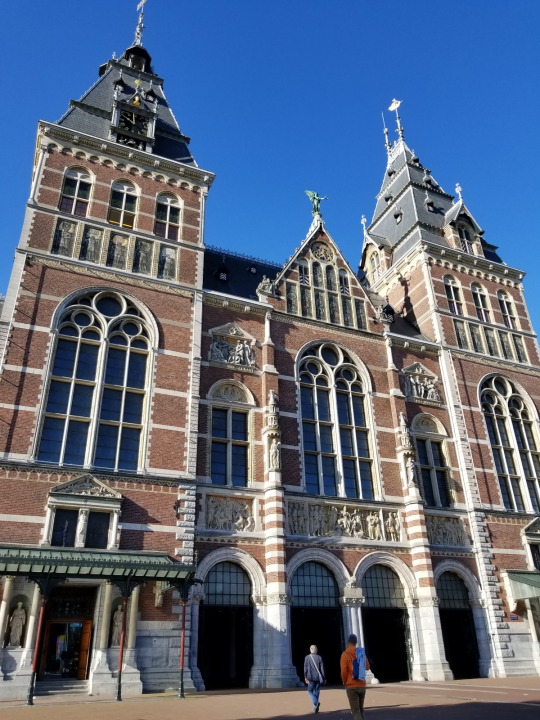
The Rijksmuseum is beautiful and massive. It resembles a cathedral from the front, with its twin spires, tall arched windows, and engraved images---not of saints and martyrs, but of artists and scholars.

Inside, we ran yet again into our old friend Laocoön one last time. Note how in this depiction, Laocoön's right arm is extended horizontally outward instead of bent back at the elbow. As we'd learned back in the Vatican archives, that means that this statue (or possibly the copy that it was a copy of) was made before 1906, when the original statue's missing right arm was finally discovered. Before then, most experts believed that Laocoön's arm had been extended in the way we see here. Given the aesthetic principles of Greek and Roman sculpture, it seemed obvious.
But Michelangelo had known better.
Four hundred years earlier, when tasked by the Vatican to reassemble the recently unearthed statue, Michelangelo could tell that the right arm was supposed to be bent. Just by looking at the musculature of the one-armed statue, he deduced that, 1) the original Greek sculptor was as much a master of human anatomy as he was himself, and 2) that the way the muscles in the sculpture's back were flexed meant that the model posing for the statue had to have had his arm bent back at the elbow. And he was right. It's like something out of Sherlock.
Bypassing the rest of the museum for now, we headed straight upstairs to the main event: the Gallery of Honor, a purpose-built grand hall exhibiting the best of the best of the Dutch Golden Age.
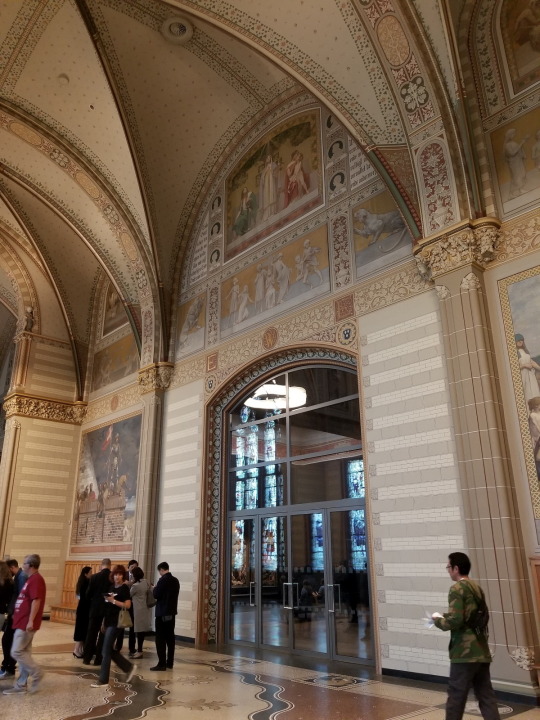


The museum's cathedralesque motif resumed at the top of the stairs. Light poured into the gallery's antechamber through stained glass windows venerating the great artists and thinkers of Western civilization.

The Rijksmuseum's Gallery of Honor is a brilliant idea that I think more museums should embrace. It consists of a long, vaulted corridor lined with alcoves dedicated to the greatest works of the greatest Dutch artists from the Golden Age. Even if you only had one hour to visit the museum, you could spend the entire hour here and leave contented that you made good use of your time.
The previous day, we'd been so impressed by the Mauritshuis in The Hague for its impressively manageable collection. In a way, the Gallery of Honor does an admirable job of creating the same effect in a much larger museum---it makes the unmanageable manageable.
Rather than rushing around trying to see all the most important stuff---our visit to the Louvre in a nutshell---the Rijksmuseum brings all the most important stuff to you in one easy room. Then, if you have more time, you can relax and explore the rest of the museum's fantastic collections at your leisure, free to guiltlessly explore whichever exhibits happen to tickle your curiosity.
But enough about design theory; let's get to the art.

One of our favorite artists featured in the room was Jan Steen. A natural comedian and storyteller among the Golden Age artists, Steen made paintings that were colorful, fun, and lowbrow with a snarky undercurrent of social commentary.


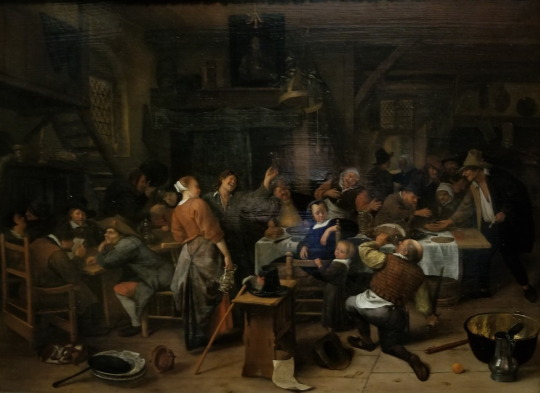
Many of Steen's paintings feature large families or groups of revelers, and the level of detail is amazing. His faces are brilliantly emotive, and every person exudes a sense of story. One of my favorites is Prince's Day, which shows a raucous tavern scene. There are over twenty characters in the picture, and every one of them feels fully alive and engaged with what's happening---even the barely visible couple whispering to each other in the background.
But the real punchline is a barely-there portrait of the prince hanging in the murky recesses of the ceiling. These people couldn't care less that they're supposedly celebrating the prince's birthday; they're just happy for any excuse to drink and be merry. And the primly dressed little girl looking straight out at you from the middle of the scene seems to know it, too.


It's no surprise that Jessica and I both loved the work of Van Ruisdael, the Golden Age's master landscape artist. I was particularly struck by his painting of The Windmill at Wijk bij Duurstede. It shows a picturesque windmill standing near a river. The nearby town is just discernible by the roofs of the local church and castle peeking up in the distance. Late afternoon sunlight beautifully illuminates the windmill at a dramatic angle, and at first the scene seems idyllic. Looking closer, however, you can see the clouds are becoming ominously dark, and the surface of the river is marked by a noticeable chop.
I may be overthinking it, but with the way the windmill dominates the scene while the castle and church fade into the background, it seems as though Ruisdael had something to say about the relative positions of industry, government, and religion in Golden Age Dutch society. Perhaps even about which way the winds were blowing, so to speak.


Another of the honored greats was Frans Hals, with his ability to create portraits that are remarkably heartwarming and instantly likeable.


And of course, there was Vermeer---the once-nearly-forgotten master of light and color whose slow and fastidious technique (along with his relatively early death) left him with remarkably few paintings to his name. As we'd learned the day before at the Mauritshuis, the Rijksmuseum has the largest collection of paintings by Vermeer in the world: four. And while the Mauritshuis has the iconic Girl With a Pearl Earring, the Rijksmuseum has some classics, too, including The Love Letter, The Milkmaid, and Woman Reading a Letter.

At least, usually. When we visited, however, Woman Reading a Letter was on loan to the Alte Pinakothek in Munich. Luckily, Jessica and I had already been there and seen that.

Another particularly interesting canvas came in the unlikely form of an angrily defecating swan. The life-size Threatened Swan was painted by Jan Asselijn as a straightforward nature scene, showing the drama of a swan defending its nest from a curious dog. But that's just the beginning of its story.
Over a hundred years later, simple nature paintings had gone out of style. People wanted art to be rich with symbolism---whether or not the artist actually intended it. The Threatened Swan was therefore "improved" by the addition of allegorical labels, effectively turning it into a glorified nationalist political cartoon. The swan's eggs were labelled "Holland," the dog was labelled "enemies of the state," and the swan was the Dutch government defending the people of Holland from their enemies.

Last but not least was Rembrandt, the big daddy of the Golden Age painters. Rembrandt was a master of pretty much every genre of painting, but his trademark was large-scale group portraits. It was a mark of pride during the Golden Age for professional organizations to commission group portraits of their members. And Rembrandt had a unique talent for turning what would normally have been a dull lineup of doctors or lawyers into a lively and interesting scene.

The ultimate room at the end of the Gallery is dedicated to Rembrandt's massive Night Watch. The room was designed specifically to showcase it, and the rest of the Gallery grew from there.
Today, at least, the painting is considered a spectacular masterpiece. But as soon as he finished it, Rembrandt’s group portrait commissions immediately dried up. Whether this was the result of dissatisfaction with the painting or an unfortunate coincidence caused by an economic downturn is a matter of speculation. In any case, this painting represents the high-water mark of Rembrandt's career.
Another funny story about The Night Watch is that the name is a total misnomer. The painting's actual name is the more accurate but less catchy Militia Company of District II under the Command of Captain Frans Banninck Cocq. Due to the improper use of a dark varnish, the image became so dark that people mistook it for a night scene.
It was only in the 1940s that the varnish was finally removed to reveal the truth. And just over a month after we saw it, the Rijksmuseum began a new restoration project that will hopefully reveal even more lost details. The painting is still on display, though---it is being worked on in public, behind a glass wall that has taken over the center of the room. You can even livestream it on the Rijksmuseum's website.
Having finished our tour of the Gallery of Honor, we were free to wander the rest of the museum to see what we could see.
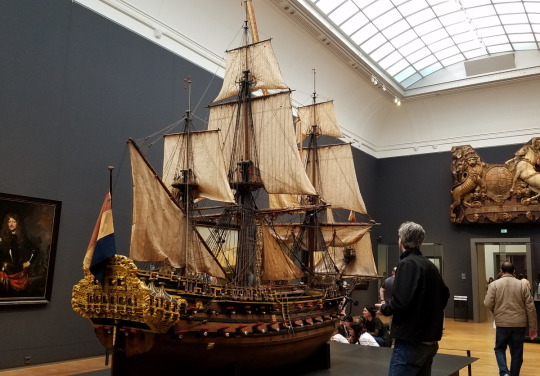
A nearby room on the same floor was dedicated to Dutch naval art and history. Above the door hangs a trophy that we found as hilarious as it was interesting. For everyone else, it will take a bit of explaining.

Thanks to our travels in the UK, Jessica and I were able to immediately recognize the emblem on this ship’s stern carving as the British royal crest. So, what was a piece of a royal British ship doing hanging in a Dutch museum? The bulk of the room is dedicated to explaining the story.

In a daring raid, Dutch captain Michiel de Ruyter sailed his fleet up the English River Medway and captured over a dozen English warships, including the English flagship HMS Royal Charles. He towed the Royal Charles back to Amsterdam, where it was put on display as a tourist attraction---to the great annoyance of its namesake King Charles II of England.
The ship was eventually broken up for scrap, and this stern piece was kept as a trophy of the catastrophic embarrassment they had wrought upon the British navy.
That was what Jessica and I found so hilarious.



De Ruyter became a national hero in the Netherlands, and even King Louis XIV of France---with whom the Dutch were not on particularly good terms---honored De Ruyter just for sticking it to the English.

Another nearby room was filled with landscape paintings, including one that Jessica and I recognized instantly for its style as the work of our favorite artistic discovery of the trip: Claude Lorrain. A nearby plaque explained that, much like Claude, many of the great Dutch landscape artists honed their skills while studying abroad in Rome.



We also saw some truly insane dollhouses. Apparently, it was popular among a certain class of wealthy Dutch merchants to show off buy commissioning absurdly opulent dollhouses. The houses were incredibly detailed, with miniature recreations of real paintings on the walls. One of these dollhouses on display was as tall as a person and cost more than an actual house in its day.

And of course, once a merchant had spent a considerable fortune on completing their dollhouse, it was only natural for them to then commission an artist to do a painting of it.


One of the larger rooms was dedicated to the famous ceramic pottery made in the Dutch city of Delft.
We learned that the tremendous success of "Delft Blue" pottery industry is partly due to Queen Mary II of England, wife of William of Orange. Mary loved the blue-and-white ceramics that the Dutch were importing from China and Japan. Naturally, this started a craze among well-to-do Dutch and English women who wanted to copy her style. There were only so many imported ceramics to go around, however, so it was only a matter of time before a group of Dutch artisans cracked the secret and began making their own domestic versions.
Delft Blue pottery ended up becoming so renowned that it was even exported back to China and Japan.


There's even an artistic offshoot dedicated to creating illustrated Delft Blue tiles as an alternative to canvas paintings.


Downstairs, we saw some impressive Post-Impressionist paintings, including self-portraits by Van Gogh and his friend Emile Bernard.

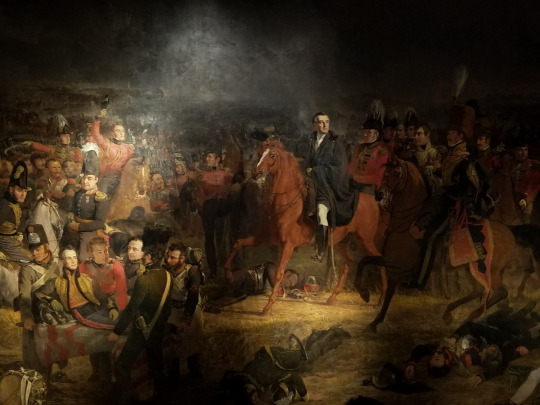
Before leaving the museum, we made sure to see one last highlight of the museum---a massive floor-to-ceiling painting by Jan Willem Pieneman of the victorious Dutch and British forces after the battle of Waterloo. The painting was commissioned by the Duke of Wellington to celebrate his victory, and he can be seen in the center of the painting, illuminated with a shaft of light as if by God. But the Dutch King William I saw the painting and liked it so much that it bought it out from under Wellington and gave it to his son Prince William II. The prince is also featured in the painting, in the lower left corner, being carried off the battlefield on a stretcher.



After leaving the museum, we took another stroll through Vondelpark, which we'd visited before after seeing the Van Gogh Museum. It's a big park, but trees and canals do a nice job of dividing it into cozy-feeling sections where you can almost feel alone with nature.
It was beautiful and serene, except for one mildly horrifying sight we came upon when we had to cross under an overpass.

Our next goal of the day was to find some oliebol, a sort of Dutch doughnut hole that Nic was determined to try. We found a highly rated bakery, but we were sadly informed that oliebols are only really made around Christmas. So instead, we made do with some raspberry-redcurrant tarts that were to die for.

(Don’t ask about the potato…)
The tarts had an unusually thick, cookie-like crust. Jessica tried to wheedle the secret out of the man behind the counter, but he either didn’t know or just played dumb.


With nothing better left to do, it was finally time to cash in the canal boat tour vouchers that we'd gotten in a package deal with our Van Gogh Museum tickets and the windmill countryside tour. It's no less touristy than any of the big City Sightseeing bus tours, but we still had fun and learned a bit.



We learned that the three U-shaped canals that belt the center of Amsterdam were dug during the Golden Age, when Amsterdam’s population quadrupled in size and necessitated a major city expansion. The inner ring was for royals and nobility, the middle ring was for wealthy merchants, and the outer ring was for the working class and warehouses.
Today, even the outer ring is such valuable property that only things like banks and high-end boutiques can afford it.

As much as any of the other amazing sights, we were also impressed by how daringly close the drivers of Amsterdam park their cars to the edge of canals.

We also learned the story behind Amsterdam’s city crest---a red shield with a vertical black bar and three white X's (more formally known as crosses of St. Andrew). The red shield symbolizes the city, the black line symbolizes the Amstel river that runs through the city, and the three crosses of St. Andrew represent divine protection from fires, floods, and plagues.
The use of red and black to represent the city and the river seemed odd at first, but as we talked about it after the cruise, we soon realized that we were walking on red brick streets and looking out at a shimmering river that looked like glinting obsidian in the sunlight.


We decided to end the day with a meal at Europe’s oldest floating Chinese restaurant. Another thing we'd learned on the canal tour was that Amsterdam has the oldest Chinatown in continental Europe. (Jessica and I had already learned that Liverpool has the oldest Chinatown in all of Europe.)
Well, we almost ended the day there.
Nicolas wouldn’t be satisfied with our stay in Amsterdam until we'd had some of the churros we’d seen in bakeries and chip shops around town all week.
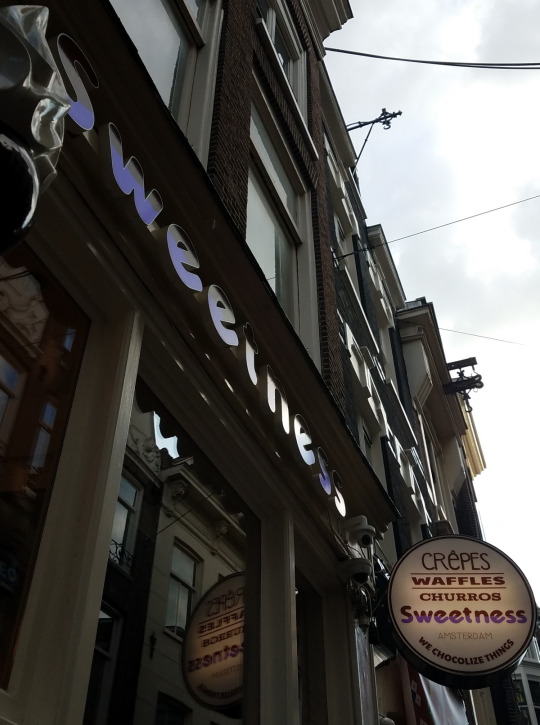
Venturing back into the streets, we found a hole-in-the-wall ice cream joint near the Red Light District called Sweetness. We ducked inside and soon found ourselves ordering something called the Red Light Special, which looked like a sort of churro sundae in the pictures on the overhead menu.
It wasn’t until the server turned out the lights and shouted “Are you ready?!” that we began to wonder whether we had ordered something we hadn’t intended to.

It was a churro and ice cream extravaganza, complete with red sparklers and a powdered-sugar fireball.

As ridiculous as it was, it was also delicious and just the right size for the three of us.

With our stomachs full of sweets, it was finally time for us to head home and start packing up. Tomorrow we would be flying to Iceland for a 48-hour cherry to cap off our six-month adventure. It’s been an amazing ride, and it’s hard to believe it’s already almost over.
#180abroad#amsterdam#netherlands#rijksmuseum#canal cruise#churros in the red light#museum#art#history#travel
0 notes
Photo

New Post has been published on https://shovelnews.com/comedian-eshaan-akbar-i-want-people-to-see-the-funny-side-of-the-koran/
Comedian Eshaan Akbar: 'I want people to see the funny side of the Koran'


Eshaan Akbar is a diplomatic provocateur.
The 33-year-old stand-up is one of the BBC Asian Network’s latest breakout talents. He first made waves on the comedy circuit supporting Micky Flanagan on tour in 2014 but now he’s wading into choppier waters. His latest set-piece, Prophet Like It’s Hot, aims to show the Koran “is actually quite funny” at the Edinburgh Fringe.
“If someone kills me for doing this, which a lot of people are worried about, I think it will at least make people sit up and take notice,” says Akbar, tucking into a halloumi burger at Bill’s in Kensington. “I don’t know if I want to die for my job — I’ve got plenty more shows left in me — but what a legacy that would leave, eh?”
Dangerously funny, maybe. But there’s plenty of humour to be found in religion, a fact that’s crucial to the show’s mandate of demystifying Islam. “Comedy is an integral part of making people think and feel differently about issues,” he says. “I want people to be challenged, have conversations and feel uncomfortable. Well, fundamentally I want them to laugh. They can feel uncomfortable while in a plush seat and not walking out, hopefully.”
Edinburgh Fringe comedian Olga Koch on coming from Russia with laughs
Three weeks ago a woman came up to him after a preview show. “It turned out she was on that train at Parson’s Green with the bomber on, and had sat opposite him,” says Akbar. “She was in tears because she said that ever since that incident she’s struggled to reconcile her relationship with people from the Islamic community and the fact of what could have happened to her. So she cried and held me because she said I made terrorism funny. I was able to somehow make her laugh about a quite serious thing, and there’s something wonderful about that.”
Born in Whitechapel, Akbar’s family moved to Essex and he attended a Church of England school, Stonebridge, on a scholarship. “I was a bit of a misfit, the poor brown boy at a private school in Essex,” he says.
It was a nuclear family at home: mum a Bangladeshi Thatcherite, his dad a Pakistani Labourite, both strictly following the tenets of Islam (he has a younger brother, now a teacher). “When I visited Bangladesh I was too British to be Bangladeshi, and here I’m too Bangladeshi to be British,” he says. “It’s weird. My mum first heard me speak English when I was seven, and I had a bit of an Essex twang, which would not wash. She’d pull out her favourite book, Wuthering Heights, and say: ‘I want you to read this like you’re on the BBC. If you start swallowing your ts I’ll smack you’. I gave Heathcliff a Yorkshire accent, which really annoyed her.”
Yet Akbar hasn’t been a practising Muslim for years now. This, he says, grants him perspective. “I was raised within the faith but my mum said: ‘The lottery of life meant that you were born a Muslim. I’ll tell you Islam is great but if I’d been Jewish I’d be saying Judaism is great. The same if I’d been born a Christian’. So with that upbringing I was always able to respect everything.”
The best comedy at Edinburgh Fringe 2018
9 show all
1/9 The best comedy at Edinburgh Fringe 2018
Jen Brister
Idil Sukan
2/9 The best comedy at Edinburgh Fringe 2018
Sara Barron
Carla Guler
3/9 The best comedy at Edinburgh Fringe 2018
Rosie Jones
Aemen Sukkar
4/9 The best comedy at Edinburgh Fringe
Suzi Ruffell
Jiksaw
5/9 The best comedy at Edinburgh Fringe 2018
Jamali Maddix
6/9 The best comedy at Edinburgh Fringe 2018
Nish Kumar
BBC/Endemol Shine UK
7/9 The best comedy at Edinburgh Fringe 2018
Norris & Parker
8/9 The best comedy at Edinburgh Fringe 2018
David O’Doherty
9/9 The best comedy at Edinburgh Fringe 2018
Lazy Susan
Bobby Goulding
1/9 The best comedy at Edinburgh Fringe 2018
Jen Brister
Idil Sukan
2/9 The best comedy at Edinburgh Fringe 2018
Sara Barron
Carla Guler
3/9 The best comedy at Edinburgh Fringe 2018
Rosie Jones
Aemen Sukkar
4/9 The best comedy at Edinburgh Fringe
Suzi Ruffell
Jiksaw
5/9 The best comedy at Edinburgh Fringe 2018
Jamali Maddix
6/9 The best comedy at Edinburgh Fringe 2018
Nish Kumar
BBC/Endemol Shine UK
7/9 The best comedy at Edinburgh Fringe 2018
Norris & Parker
8/9 The best comedy at Edinburgh Fringe 2018
David O’Doherty
9/9 The best comedy at Edinburgh Fringe 2018
Lazy Susan
Bobby Goulding
He found the teachings at the mosque inflexible. “Even the revelation itself came from the prophet asking questions of society. But we weren’t taught any of the historical context. All I was told was: ‘Read this’. The first alphabet I learned to read was Arabic and I didnt know what any of it meant. If I dared to question I’d get slapped. They said: ‘This is the word of God and that’s it, don’t ask questions’. As I got older that pushed me away.”
Comedy was not his next calling though. There was a long fixation with the diplomatic corps. Three of his uncles were in the service, and used to pick him up, aged six, in a limousine. “I used to wear a clip-on lime green tie every time they visited,” he says. “I wanted to be an ambassador.”
He studied economics at Queen Mary, University of London, and bought a house in Chadwell Heath, near Romford aged 18 — “I lucked out. Easy credit.” He buckled up for a career in banking through Barclays’ graduate programme — his parents lost their house in the 1991 recession and he needed to support the family.
“The main thing I did was wealth management for celebrities. There were some big names, including a comedian of much repute whose financial affairs were a bit of a scandal.”
So… Jimmy Carr?
“Right, so there we go. You look at someone like Jimmy Carr’s bank account and the remarkable thing was he had as much money as he did. For context, to open an account with me you needed £5 million in investment assets or an annual cash flow of £450,000. So, big money. And I’m a 21-year-old going ‘I’m never going to see that much’. And he’s doing comedy.”
The best new writing to see at Edinburgh Fringe Festival 2018
He was made redundant during the 2008 financial crisis and went into occupational overdrive. He briefly reignited his diplomatic aspirations, studying for an MA at Birkbeck before dropping it. He then freelanced for The Observer and worked as a researcher for Sky News. “I’d even been a dance choreographer for a bit outside work at Barclays,” he says. “It was Bollywood. I choreographed groups for weddings, that kind of stuff.”
Then, some luck. A producer at Sky filmed him for a broadcast audition tape and spotted his flair for comedy. That was the nudge he needed. Akbar took an eight-week stand-up course and was spotted by Micky Flanagan’s agent.
In 2014 his mum died. “I had two gigs left after her passing. I was going to do them, and that was going to be it. I couldn’t think about anything but my mum. But I hadn’t realised how cathartic comedy was for me. Confronting people who didn’t know me and my story and not thinking about my mum, it just became this safe space where I could enjoy myself.”
Akbar still lives with his dad and brother but even that’s comic material. He’s written a sitcom — still in the works — about trying to find love while living with his “housemates”. “They have loads of sex and I get nothing in the show,” he says.
London’s best comedy clubs and nights
15 show all
1/15 The Soho Theatre
Sara Pascoe’s favourite comedy venue, and with good reason: the Soho Theatre is arguably London’s finest place to see both up-and-coming and established acts. Being a theatre, rather than a comedy club per se, expect to see full sets from individuals rather than bills with a few comics. Its three rooms host all sorts of things, from the latest Edinburgh winners to big names road-testing their latest bits. The standard is reliably excellent: even if you’ve never heard of a comedian, chances are, if they’re playing here, they’ll be worth watching.
2/15 The Comedy Store
Another old favourite, the Comedy Store benefits from being built for purpose: no other venue in London suits stand-up quite so well (and the beer isn’t too ridiculously priced, either). After starting out above a strip club in Soho, this place made its name throughout the eighties by breaking the pioneers in alternative comedy. It’s happy to host mainstream stars these days, and never struggles to draw top acts, but if you can only make one thing, try The Comedy Store Players, old pros whose improvised shows on Wednesdays and Sundays all but guarantee hilarity. Tuesday’s The Cutting Edge is best for those who like topical humour.
3/15 Old Rope at The Phoenix
Old Rope is popular with circuit veterans and newbies alike, so the weekly show usually has a mix of big names, comedy veterans and ones-to-watch. Host Tiff Stevenson leads an evening of new material – yes, lots of jokes given their test run – and it’s given its name for the noose that hangs over the stage. Ironically, this noose is a bit of a life-saver: if the new act is going badly, comics can grab the rope and fall back on old material.
4/15 Knock2bag
Always top value, the Knock2bag nights offer the chance to indulge in the odder end of the comedy spectrum: expect serious helpings of whimsy, eccentricity and surrealism. If you’re looking for something different, this is your place to go.
5/15 Monkey Business Comedy Club
A first-rate comedy club and well worth travelling for. We’d pick the Thursday night over Saturday, but you’ll get a decent show on either day. There’s a mix of big names and up-and-comers, and host Martin Besserman is a pro who’ll keep you laughing in between acts. Of which, there’s often as many as twelve a night, so you’ll get your money’s worth. If one isn’t to your taste, another promises a laugh.
6/15 Banana Cabaret Club
The Banana Cabaret Club hosts a lot of top drawer comics, and is well loved in comedy circles – in part, because they’ve been going a good thirty years and in part because of the man running things, David Vickers, whose had everyone from Eddie Izzard to Stephen K Amos performing. Stars pop-in, and comedy circuit regulars play often, but it’s also on the finest spots to see new talent . No wonder Marcus Brigstocke name-checked it as his favourite London comedy club. Besides, once the two-hour show is done (typically wrapping up around 11pm), DJs strike up and everyone dances till 2am. Splendid.
http://vivivi.co.uk/
7/15 Piccadilly Comedy Club
Hats off to the Piccadilly for keeping comedy cheap: their shows cost £10 at the most, and they do a ‘meal deal’, where you can eat at Tiger Tiger and see the show for £20 all-in. A bargain. Expect a mix of well-known TV regulars alongside the best newcomers on the scene. Line-ups are particularly well thought out here: they don’t just sling together anyone, so the nights tend to be uniformly excellent.
8/15 Leicester Square Theatre
The Leicester Square Theatre draws the big names, so expect to see top flight acts: Richard Herring hosts a weekly podcast here on Wednesdays, and the likes of Bridget Christie, Micky Flanagan and Frankie Boyle all make it a stopping point on their tours. That said, check the website for what’s upcoming – there are chance to see some under-the-radar sets too.
9/15 Live at Zédel
The excellent Brasserie Zédel – whose Bar Americain is one of the finest drinking spots in the capital – relaunched Crazy Coqs as Live At Zédel last year and following a successful first run, are launching their second season. Besides comedy – the standard is usually very decent – they also host musical theatre and drag acts. The cocktails are terrific and there’s at-table service. Eat in the restaurant beforehand (or after), too: we swung by recently and the food is as good as its ever been. Cheap, too.
10/15 Happy Mondays
This fortnightly show boasts the best new up-and-coming acts in the capital, combined with big name hosts – expect the likes of Miles Jupp, Sara Pascoe and Holly Walsh – who keep the standard up to scratch. Definitely up to par, somewhere to find your new favourite comedian.
11/15 Angel Comedy
Just how a comedy club should be: small, crowded and above a pub. Best of all, it’s free, and each night offers something different, from open-mic nights to well-known names giving their latest sets an airing. Check the website for details, but you won’t be let down – just get down early, as it fills up quickly.
12/15 Ginglik Comedy Club
Following a decade of success in Shepherd’s Bush, this comedy club has found a new home at the ever-popular Roof Gardens. Known as ‘Jimmy Carr’s favourite comedy club’, the Ginglik has had everyone from Al Murray to Robin Williams play, and is set for more success.
13/15 Laugh Out London
The likes of Stewart Lee, Reginald D Hunter and Tony Law play these nights, which gives an idea of just how decent they are. Laugh Out London always do a good job of bringing the highlights from Edinburgh festival to town, so take the chance to see who everyone’s been tweeting about.
14/15 The 99 Club
This Leicester Square club is much, much better than you might expect for a place that continually flyers. A big favourite with the Chortle Awards, it always attracts big names – it runs a little like ‘Live At The Apollo’ but on a smaller scale. There are three acts a night, and shows are fairly priced: some are as cheap as a fiver, though most will cost around £10 – £15. They’ve also got venues in Soho and Covent Garden.
15/15 Live At The Chapel
Bit of a shame that shows here are so few and far between – usually about once a month – but there’s no place more beautiful than the Union Chapel to see comedy in London. The upside is that, with so few performances, they always get the big names headlining, with unfailingly impressive support. Plus there’s usually a live band, who are fab. The atmosphere is everything.
Anthony Devlin/PA Wire
1/15 The Soho Theatre
Sara Pascoe’s favourite comedy venue, and with good reason: the Soho Theatre is arguably London’s finest place to see both up-and-coming and established acts. Being a theatre, rather than a comedy club per se, expect to see full sets from individuals rather than bills with a few comics. Its three rooms host all sorts of things, from the latest Edinburgh winners to big names road-testing their latest bits. The standard is reliably excellent: even if you’ve never heard of a comedian, chances are, if they’re playing here, they’ll be worth watching.
2/15 The Comedy Store
Another old favourite, the Comedy Store benefits from being built for purpose: no other venue in London suits stand-up quite so well (and the beer isn’t too ridiculously priced, either). After starting out above a strip club in Soho, this place made its name throughout the eighties by breaking the pioneers in alternative comedy. It’s happy to host mainstream stars these days, and never struggles to draw top acts, but if you can only make one thing, try The Comedy Store Players, old pros whose improvised shows on Wednesdays and Sundays all but guarantee hilarity. Tuesday’s The Cutting Edge is best for those who like topical humour.
3/15 Old Rope at The Phoenix
Old Rope is popular with circuit veterans and newbies alike, so the weekly show usually has a mix of big names, comedy veterans and ones-to-watch. Host Tiff Stevenson leads an evening of new material – yes, lots of jokes given their test run – and it’s given its name for the noose that hangs over the stage. Ironically, this noose is a bit of a life-saver: if the new act is going badly, comics can grab the rope and fall back on old material.
4/15 Knock2bag
Always top value, the Knock2bag nights offer the chance to indulge in the odder end of the comedy spectrum: expect serious helpings of whimsy, eccentricity and surrealism. If you’re looking for something different, this is your place to go.
5/15 Monkey Business Comedy Club
A first-rate comedy club and well worth travelling for. We’d pick the Thursday night over Saturday, but you’ll get a decent show on either day. There’s a mix of big names and up-and-comers, and host Martin Besserman is a pro who’ll keep you laughing in between acts. Of which, there’s often as many as twelve a night, so you’ll get your money’s worth. If one isn’t to your taste, another promises a laugh.
6/15 Banana Cabaret Club
The Banana Cabaret Club hosts a lot of top drawer comics, and is well loved in comedy circles – in part, because they’ve been going a good thirty years and in part because of the man running things, David Vickers, whose had everyone from Eddie Izzard to Stephen K Amos performing. Stars pop-in, and comedy circuit regulars play often, but it’s also on the finest spots to see new talent . No wonder Marcus Brigstocke name-checked it as his favourite London comedy club. Besides, once the two-hour show is done (typically wrapping up around 11pm), DJs strike up and everyone dances till 2am. Splendid.
http://vivivi.co.uk/
7/15 Piccadilly Comedy Club
Hats off to the Piccadilly for keeping comedy cheap: their shows cost £10 at the most, and they do a ‘meal deal’, where you can eat at Tiger Tiger and see the show for £20 all-in. A bargain. Expect a mix of well-known TV regulars alongside the best newcomers on the scene. Line-ups are particularly well thought out here: they don’t just sling together anyone, so the nights tend to be uniformly excellent.
8/15 Leicester Square Theatre
The Leicester Square Theatre draws the big names, so expect to see top flight acts: Richard Herring hosts a weekly podcast here on Wednesdays, and the likes of Bridget Christie, Micky Flanagan and Frankie Boyle all make it a stopping point on their tours. That said, check the website for what’s upcoming – there are chance to see some under-the-radar sets too.
9/15 Live at Zédel
The excellent Brasserie Zédel – whose Bar Americain is one of the finest drinking spots in the capital – relaunched Crazy Coqs as Live At Zédel last year and following a successful first run, are launching their second season. Besides comedy – the standard is usually very decent – they also host musical theatre and drag acts. The cocktails are terrific and there’s at-table service. Eat in the restaurant beforehand (or after), too: we swung by recently and the food is as good as its ever been. Cheap, too.
10/15 Happy Mondays
This fortnightly show boasts the best new up-and-coming acts in the capital, combined with big name hosts – expect the likes of Miles Jupp, Sara Pascoe and Holly Walsh – who keep the standard up to scratch. Definitely up to par, somewhere to find your new favourite comedian.
11/15 Angel Comedy
Just how a comedy club should be: small, crowded and above a pub. Best of all, it’s free, and each night offers something different, from open-mic nights to well-known names giving their latest sets an airing. Check the website for details, but you won’t be let down – just get down early, as it fills up quickly.
12/15 Ginglik Comedy Club
Following a decade of success in Shepherd’s Bush, this comedy club has found a new home at the ever-popular Roof Gardens. Known as ‘Jimmy Carr’s favourite comedy club’, the Ginglik has had everyone from Al Murray to Robin Williams play, and is set for more success.
13/15 Laugh Out London
The likes of Stewart Lee, Reginald D Hunter and Tony Law play these nights, which gives an idea of just how decent they are. Laugh Out London always do a good job of bringing the highlights from Edinburgh festival to town, so take the chance to see who everyone’s been tweeting about.
14/15 The 99 Club
This Leicester Square club is much, much better than you might expect for a place that continually flyers. A big favourite with the Chortle Awards, it always attracts big names – it runs a little like ‘Live At The Apollo’ but on a smaller scale. There are three acts a night, and shows are fairly priced: some are as cheap as a fiver, though most will cost around £10 – £15. They’ve also got venues in Soho and Covent Garden.
15/15 Live At The Chapel
Bit of a shame that shows here are so few and far between – usually about once a month – but there’s no place more beautiful than the Union Chapel to see comedy in London. The upside is that, with so few performances, they always get the big names headlining, with unfailingly impressive support. Plus there’s usually a live band, who are fab. The atmosphere is everything.
Anthony Devlin/PA Wire
Based on real life experience? “Slightly. My brother’s got a girlfriend in America and he’s having more sex than me.” He laughs. “I get no matches on Tinder. None. Muslim Tinder however, aka Minder… oh boy. You can declare how religious you are on there and a lot of girls, when they find someone who’s not religious, they’re like, ‘Oh, hello’. I’m the bad boy. I never thought I’d play that role.”
You’ve got to have faith. Even when you don’t.
Eshaan Akbar’s Prophet Like It’s Hot is at the Gilded Balloon, Edinburgh (edfringe.com) August 1-26
Source: https://www.standard.co.uk/go/london/arts/comedian-eshaan-akbar-i-want-people-to-see-the-funny-side-of-the-koran-a3895681.html
0 notes